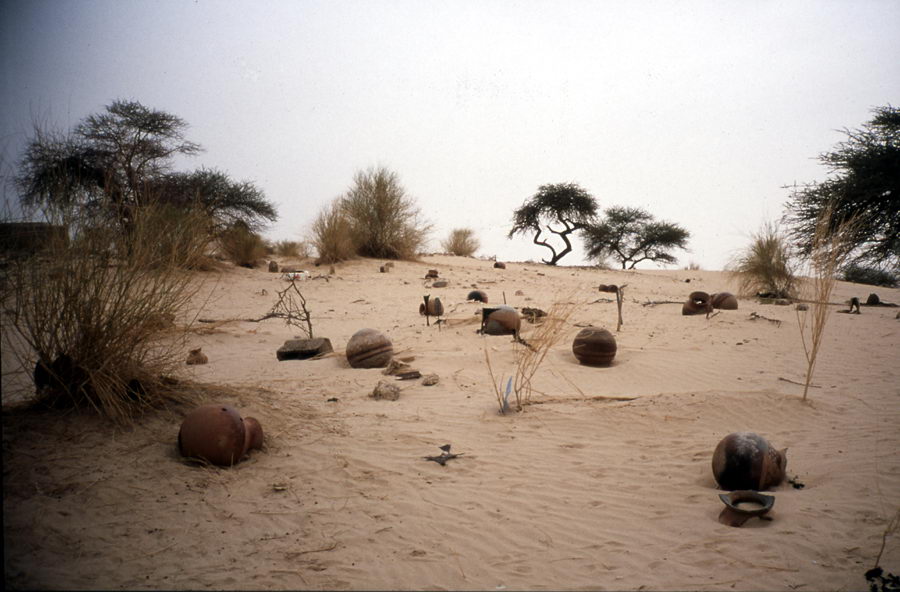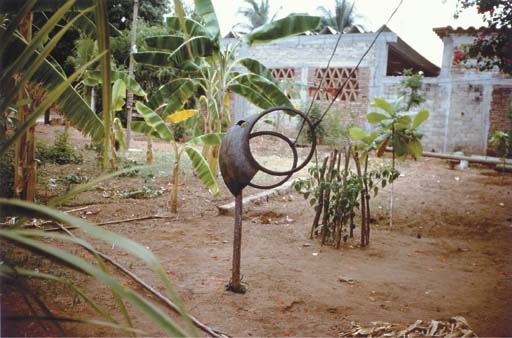
© » KADIST
Gregory Crewdson
Forest Gathering N.2 is part of the series of photographs Beneath the Roses (2003-2005) where anonymous townscapes, forest clearings and broad, desolate streets are revealed as sites of mystery and wonder; similarly, ostensibly banal interiors become the staging grounds for strange human scenarios. These scenes are tangibly atmospheric, visually alluring and often deeply disquieting. Never anchored precisely in time or place, these and the other narratives of Beneath the Roses are rather located in the dystopic landscape of the anxious American imagination.

© » KADIST
Joachim Koester
Physical and mental exploration have been founding elements in Joachim Koester’s research for several years. While exploration was mainly a matter of geography during the 19th century, the 20th century brought the mental exploration of our unconscious, triggered by the discovery of psychoanalysis. Koester is interested in documenting minor events, forgotten by History, in order to reintroduce them into collective memory.

© » KADIST
William E. Jones
In the early 20th century, the Hercules Engine Company was doing a brisk business producing customized, heavy-duty engines. Seventy years later, when the United States military started opting for Humvees and stock parts, the company began to fail, and it entirely ceased production in 1999. Hercules Engines, Abandoned, Canton, Ohio (2011) depicts the manufacturer’s former productive core, gone fallow.

© » KADIST
Gabriel Orozco
Gabriel Orozco often documents found situations in the natural or urban landscape. He travels armed with his camera and insightfully captures scenes of the everyday that other people might ignore. Perro en Tlalpan (Dog in Tlalpan, 1992) is a photograph of a dog regally perched under an industrial shelter in the borough of Tlalpan in Mexico City.

© » KADIST
William E. Jones
In Restaurant, Canton, Ohio (2011), a convenience store offers food, liquor, and Coca Cola to an empty street. A series of boarded-up storefronts marred by peeling paint conveys a sense of the pre- or post-apocalyptic—the hush just before or after a disaster. The reds, pinks, and oranges of the buildings give off warmth, but the absence of human activity makes the glow eerie and strange.

© » KADIST
William E. Jones
Killed is a video projection in which William E. Jones appropriated and edited, in a rapid sequence, a selection from the more than 68,000 censored or discarded films produced by the Farm Security Administration’s photographers between 1935 and 1943. Roy Emerson Stryker, the then director of the program, was in charge of what he called “killing” negatives by punching holes in them to render them unusable. Killed continues Jones’s use of discarded film footage seen in his video created from vintage 1970s and 1980s gay porn that was included in the 2008 Whitney Biennial.

© » KADIST
Joachim Koester
Tarantism is the name of disease which appeared in southern Italy, resulting from the bite of a spider called Tarantula. This bite caused various symptoms, such as nausea, difficulty to speak, delusion, excitability and agitation. The victims suffered then from convulsions and the only way to heal them was to engage in a frenzied dance, as it was believed.

© » KADIST
William E. Jones
His series, The Golden State, harkens back to his early career and his photographic training. Using a still camera to compose the fifty images of the series, Jones turns his lens on the vernacular architecture of California’s southern region, looking at the iconic and idiosyncratic spaces that define a region. William E. Jones is a filmmaker, writer, and artist whose interests lie in the circulation of images—images that are broadcast, images that are hidden, and images that become imbedded in our collective consciousness.

© » KADIST
Gabriel Orozco
Gabriel Orozco comments: “In the exhibition [Documenta 11, Kassel, 2002], I tried to connect with the photographs I took in Mali in July. I traveled to Mali for three weeks and took some photographs related to my work. They are very different, but there are links as the graveyard of Timbuktu, which I discovered during the trip.

© » KADIST
Chen Shaoxiong
After engaging primarily with video and photography for more than a decade, Chen turned to painting to explore the issue of urban change and memories—both personal and collective. This “return to origin” reveals an interesting critical reflection on the interactive relation between outside change and internal reflection, and the possibility for more experimental approaches that revive “traditional media.” Chen’s series Collective Memories depicts some of the most important architectural works and urban sites in modern Chinese society, especially those related to the history of revolutions. Instead of reproducing the images himself, Chen invited the public to participate in their making by using their fingers to paint directly on the paper or canvas.

© » KADIST
Gabriel Orozco
Charco portátil congelado (Frozen Portable Puddle, 1994) is a photographic record of an installation of the same name that Gabriel Orozco made at Witte de With Center for Contemporary Art in Rotterdam for the group exhibition WATT (1994). The artist arrived a week prior to the opening with no artwork to install, and created three spontaneous works from locally sourced materials. This one was made of white plastic record sleeves that Orozco arranged on the damp roof of the gallery.

© » KADIST
Chen Shaoxiong
After engaging primarily with video and photography for more than a decade, Chen turned to painting to explore the issue of urban change and memories—both personal and collective. This “return to origin” reveals an interesting critical reflection on the interactive relation between outside change and internal reflection, and the possibility for more experimental approaches that revive “traditional media.” For Ink Diary , Chen recorded his daily life and impressions within a rapidly-changing urban setting in ink wash paintings which he then turned into an animated film. The complex result of this simple process is both highly innovative and reflective of modernization.
Gabriel Orozco
- location: New York City, Paris
- location: Mexico
- year born: 1962
- gender: male
- nationality: Mexican
- home town: Jalapa, Mexico
Joachim Koester
- year born: 1962
- gender: male
- nationality: Danish
- home town: Copenhagen, Denmark
Chen Shaoxiong
- location: Beijing
- location: Guangzhou, China
- year born: 1962
- gender: male
- nationality: Chinese
- home town: Shantou, Guangdong Province, China
Gregory Crewdson
- location: New York, New York
- year born: 1962
- gender: male
- nationality: American
- home town: Brooklyn, New York
-
1990-1999
Gabriel Orozco
1992Gabriel Orozco often documents found situations in the natural or urban landscape...
Gabriel Orozco
1994Charco portátil congelado (Frozen Portable Puddle, 1994) is a photographic record of an installation of the same name that Gabriel Orozco made at Witte de With Center for Contemporary Art in Rotterdam for the group exhibition WATT (1994)...
-
2000-2009
William E. Jones
2000His series, The Golden State, harkens back to his early career and his photographic training...
Gabriel Orozco
2002Gabriel Orozco comments: “In the exhibition [Documenta 11, Kassel, 2002], I tried to connect with the photographs I took in Mali in July...
Gregory Crewdson
2005Forest Gathering N.2 is part of the series of photographs Beneath the Roses (2003-2005) where anonymous townscapes, forest clearings and broad, desolate streets are revealed as sites of mystery and wonder; similarly, ostensibly banal interiors become the staging grounds for strange human scenarios...
Joachim Koester
2006Physical and mental exploration have been founding elements in Joachim Koester’s research for several years...
Chen Shaoxiong
2006After engaging primarily with video and photography for more than a decade, Chen turned to painting to explore the issue of urban change and memories—both personal and collective...
Joachim Koester
2007Tarantism is the name of disease which appeared in southern Italy, resulting from the bite of a spider called Tarantula...
Chen Shaoxiong
2007After engaging primarily with video and photography for more than a decade, Chen turned to painting to explore the issue of urban change and memories—both personal and collective...
-
2010-2019
William E. Jones
2011In the early 20th century, the Hercules Engine Company was doing a brisk business producing customized, heavy-duty engines...
William E. Jones
2011In Restaurant, Canton, Ohio (2011), a convenience store offers food, liquor, and Coca Cola to an empty street...

